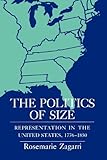The Politics of Size : Representation in the United States, 1776–1850 / Rosemarie Zagarri.
Material type: TextPublisher: Ithaca, NY : Cornell University Press, [2018]Copyright date: ©2010Description: 1 online resource (180 p.) : 6 maps, 4 tablesContent type:
TextPublisher: Ithaca, NY : Cornell University Press, [2018]Copyright date: ©2010Description: 1 online resource (180 p.) : 6 maps, 4 tablesContent type: - 9781501711367
- 321.02/0973
- JK1071.Z34 1987
- online - DeGruyter
| Item type | Current library | Call number | URL | Status | Notes | Barcode | |
|---|---|---|---|---|---|---|---|
 eBook
eBook
|
Biblioteca "Angelicum" Pont. Univ. S.Tommaso d'Aquino Nuvola online | online - DeGruyter (Browse shelf(Opens below)) | Online access | Not for loan (Accesso limitato) | Accesso per gli utenti autorizzati / Access for authorized users | (dgr)9781501711367 |
Browsing Biblioteca "Angelicum" Pont. Univ. S.Tommaso d'Aquino shelves, Shelving location: Nuvola online Close shelf browser (Hides shelf browser)

|

|

|

|

|

|

|
||
| online - DeGruyter Changing by Design : Organizational Innovation at Hewlett-Packard / | online - DeGruyter Beyond Consolation : Death, Sexuality, and the Changing Shapes of Elegy / | online - DeGruyter The Metaphysics of Beauty / | online - DeGruyter The Politics of Size : Representation in the United States, 1776–1850 / | online - DeGruyter Taming Democracy : Models of Political Rhetoric in Classical Athens / | online - DeGruyter Isolated Cases : The Anxieties of Autonomy in Enlightenment Philosophy and Romantic Literature / | online - DeGruyter International Governance : Protecting the Environment in a Stateless Society / |
Frontmatter -- Contents -- Maps -- Preface -- Introduction: The Dimensions of the Problem -- 1. The Centrality of State Capitals -- 2. Apportionment Divides the States -- 3. The Large State-Small State Controversy Revisited -- 4. Representation and the Extensive Republic -- 5. Creating Congressional Constituencies -- 6. The Persistence of the Large State-Small State Conflict -- Epilogue: Beyond Boundlessness -- Appendix Tables -- Index
restricted access online access with authorization star
http://purl.org/coar/access_right/c_16ec
After the Revolution, Americans faced the challenge of expanding representative government throughout an extensive territory. The complex process of adapting republicanism to a vast area generated many conflicts over representation in both states and the nation—conflicts that produced a division between the large states and the small states. Using concepts of historical geography, Rosemarie Zagarri examines how Americans' notions about space influenced the writing of the U.S. Constitution and the shaping of the nation's political institutions.In The Politics of Size, Zagarri offers a bold explanation of political alignments in the early republic. The split between large and small states emerged, she asserts, not at the Constitutional Convention of 1787 but in the years before, during debates over the relocation of state capitals and the reapportionment of state legislatures. The local conflicts culminated in the fierce struggle between the two factions at the federal convention. Far from ending there, the division persisted well into the nineteenth century, resurfacing when Congress discussed such controversial issues as congressional redistricting, the selection of presidential electors, and the reapportionment of the House of Representatives. Only in 1850 did the conflict based on state size merge with, and become subsumed by, the growing controversy between North and South.
Mode of access: Internet via World Wide Web.
In English.
Description based on online resource; title from PDF title page (publisher's Web site, viewed 26. Apr 2024)


